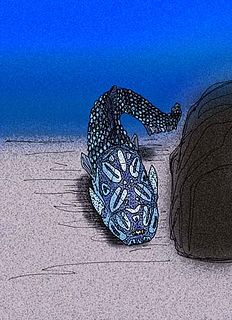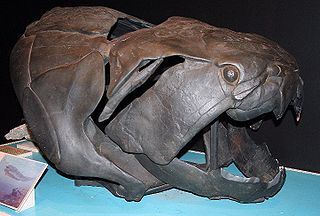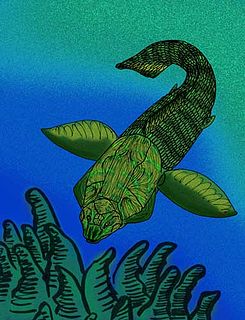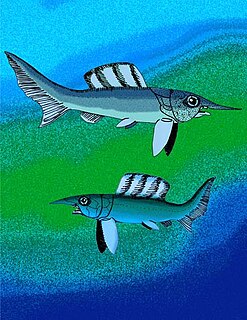
Placodermi is a class of armoured prehistoric fish, known from fossils, which lived from the Silurian to the end of the Devonian period. Their head and thorax were covered by articulated armoured plates and the rest of the body was scaled or naked, depending on the species. Placoderms were among the first jawed fish; their jaws likely evolved from the first of their gill arches.

Mizia is a genus of primitive antiarch placoderm found in Emsian-aged marine strata of Early Devonian China.

Protaspididae is an extinct family of pteraspidid heterostracan agnathans. Fossils of the various genera are found in early Devonian-aged marine strata. Protaspidids were once thought to represent a transitional form between the Pteraspididae and the Psammosteida, bearing the broad head shield shape of the latter, due to a more benthic (bottom-dwelling) existence, but recent phylogenical comparisons demonstrate that the protaspidids are actually highly derived pteraspidids, and that the anchipteraspidids, the most primitive of pteraspidids, are the sister-group of the Psammosteids.

Dunkleosteus is an extinct genus of large armored, jawed fishes that existed during the Late Devonian period, about 382–358 million years ago. It consists of ten species, some of which are among the largest placoderms to have ever lived: D. terrelli, D. belgicus, D. denisoni, D. marsaisi, D. magnificus, D. missouriensis, D. newberryi, D. amblyodoratus, and D. raveri. The largest and most well known species is D. terrelli, which grew up to 8.79 m (28.8 ft) long and 4 t in weight. Dunkleosteus could quickly open and close its jaw, like modern-day suction feeders, and had a bite force of 6,000 N at the tip and 7,400 N at the blade edge. Numerous fossils of the various species have been found in North America, Poland, Belgium, and Morocco.

Bothriolepis was a widespread, abundant and diverse genus of antiarch placoderms that lived during the Middle to Late Devonian period of the Paleozoic Era. Historically, Bothriolepis resided in an array of paleo-environments spread across every paleocontinent, including near shore marine and freshwater settings. Most species of Bothriolepis were characterized as relatively small, benthic, freshwater detritivores, averaging around 30 centimetres (12 in) in length. However, the largest species, B. rex, had an estimated bodylength of 170 centimetres (67 in). Although expansive with over 60 species found worldwide, comparatively Bothriolepis is not unusually more diverse than most modern bottom dwelling species around today.

Rhenanida is an order of scaly placoderms. Unlike most other placoderms, the rhenanids' armor was made up of a mosaic of unfused scales and tubercles. The patterns and components of this "mosaic" correspond to the plates of armor in other, more advanced placoderms, suggesting that the ancestral placoderm had armor made of unfused components, as well.

Phyllolepida is an extinct taxon of flattened placoderms found throughout the world, with fossils being found in Devonian strata. Like other flattened placoderms, the phyllolepids were bottom-dwelling predators that ambushed prey. Unlike other flattened placoderms, the phyllolepids were inhabitants of freshwater environments.

Acanthothoraci is an extinct group of chimaera-like placoderms who were closely related to the rhenanid placoderms. Superficially, the acanthoracids resembled scaly chimaeras, or (relatively) heavily armored ptyctodonts. They were distinguished from chimaeras by the presence of large scales and plates, a pair of large spines that emanate from their chests, tooth-like beak plates, and the typical bone-enhanced placoderm eyeball. They were distinguished from other placoderms due to differences in the anatomy of their skulls, and due to patterns on the skull plates and thoracic plates that are unique to this order.

Dunkleosteidae is an extinct family of arthrodire placoderms that lived during the Devonian period. The gigantic apex predator Dunkleosteus terrelli is the best known member of this group.

Lunaspis is an extinct genus of armor-plated petalichthyid placoderm fish that lived in shallow marine environments of the Early Devonian period, from approximately 409.1 to 402.5 million year ago. Fossils have been found in Germany, China and Australia. There are three different identified species of within the genus Lunaspis: L. broilii, L. heroldi, and L. prumiensis.

Minicrania is an extinct genus of tiny antiarch fish, with armor averaging up to about 2 centimetres (0.79 in) long, which lived during the Lochkovian epoch in Early Devonian Yunnan Province, China and northern Vietnam.

Homosteus is a genus of flattened arthrodire placoderm from the Middle Devonian. Fossils are found primarily in Eifelian-epoch aged strata of Europe, Canada, Greenland, and Estonia. All of the species had comparatively large, flattened heads with, as suggested by the upward opening orbits, upward-pointing eyes. These adaptations suggest that the various species were benthic predators. A study on Titanichthys, in contrast, suggests that species of Homosteus may have been filter-feeders instead.

Holonema is an extinct genus of relatively large, barrel-shaped arthrodire placoderms that were found in oceans throughout the world from the Mid to Late Devonian, when the last species perished in the Frasnian-Fammian extinction event. Most species of the genus are known from fragments of their armor, but the Gogo Reef species, H. westolli, is known from whole, articulated specimens. According to these specimens, species of Holonema lived by grazing on stony, horn-shaped, stromatolite-like algae called oncholite, apparently by snipping off the points with a specialized snout.

Holonematidae is an extinct family of relatively large arthrodire placoderms from the Early to Late Devonian. Almost all fossil specimens are of armor fragments, though, all have distinctive ornamentation, often of unique arrangements and patterns of tubercles, that are diagnostic of the family. The trunkshield is very elongated, giving the armor an overall "barrel" like appearance.

Buchanosteidae is a family of arthrodire placoderms that lived from the Early to Middle Devonian. Fossils appear in various strata in Russia, Central Asia, Australia, and China.

Oxyosteus is a genus of trout-sized, highly compressed arthrodire placoderms from the Late Devonian of Europe: The two described species are restricted to the Late Frasnian-aged Kellwasserkalk Fauna of Bad Wildungen, while a median dorsal plate of an unnamed species is known from the Middle Frasnian Holy Cross Mountains of Poland.
Microbrachius is an extinct genus of tiny, advanced antiarch placoderms closely related to the bothriolepids. Complete articulated specimens show that the armored section of the body had an average length of 2-4 cm. Species of Microbrachius are characterized by having large heads with short thoracic armor. Specimens of Microbrachius have been found in Scotland, Belarus, Estonia, and China. Specimens range in age from the Lower Devonian Late Emsian Stage to the Middle Devonian Upper Givetian Stage.

Pteraspidiformes is an extinct order of heterostracan agnathan vertebrates known from extensive fossil remains primarily from Early Devonian strata of Europe and North America, and from Upper Silurian Canada.

Asterolepis is an extinct genus of antiarch placoderms from the Devonian of North and South America and Europe. They were heavily armored flat-headed benthic detritivores with distinctive jointed limb-like pectoral fins and hollow spine. The armor plate gives the Asterolepis a box-like shape. Its pectoral fins are also armored but the caudal and dorsal fin are not. The first fossils were named by M. Eichwald in 1840 after noticing star-like markings on the fossils.

Wufengshania is an extinct genus of bothriolepidid placoderm from the Emsian epoch of China. The type species, Wufengshania magniforaminiswas named by Zhaohui Pan et al., 2018.



















